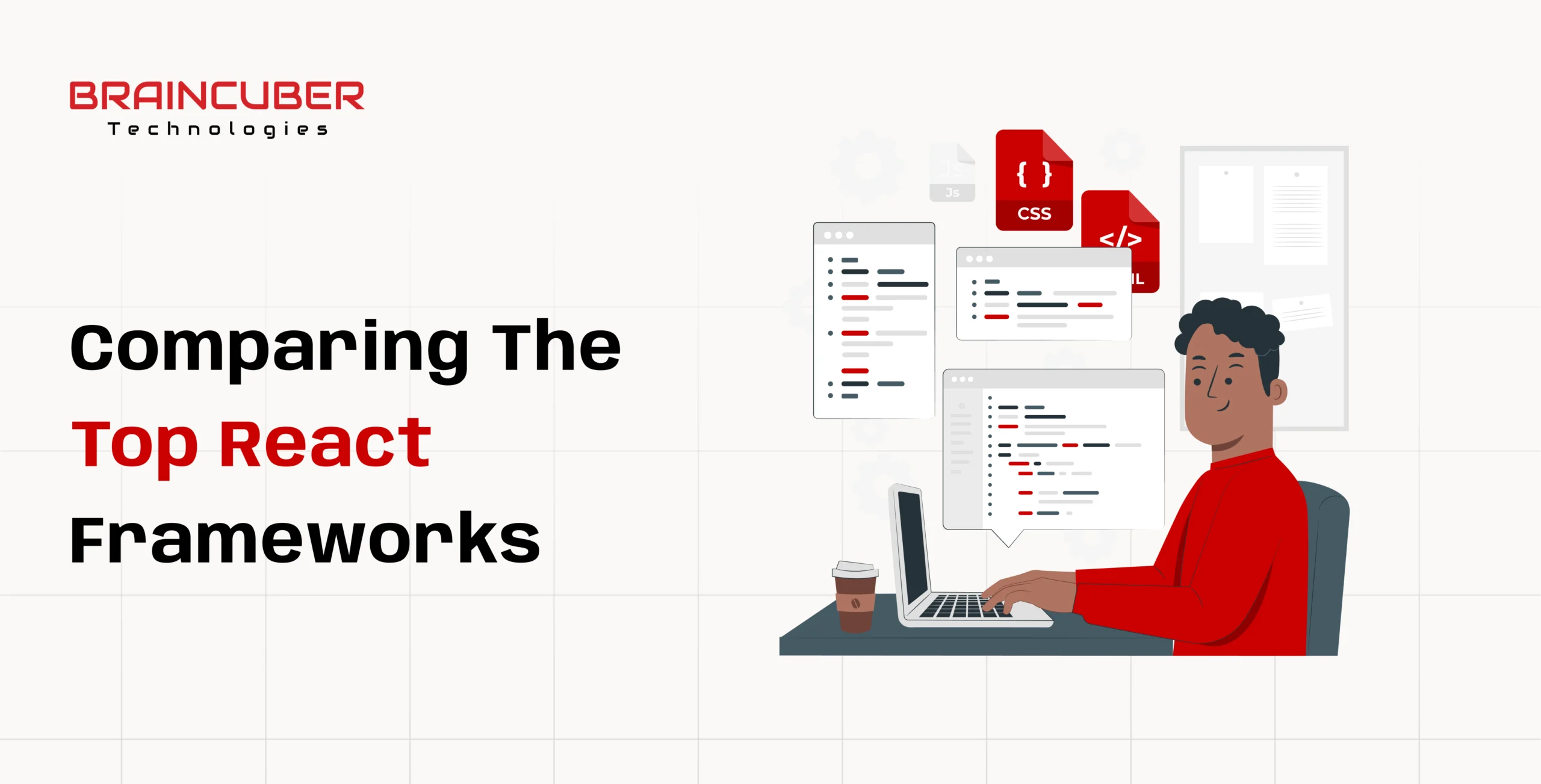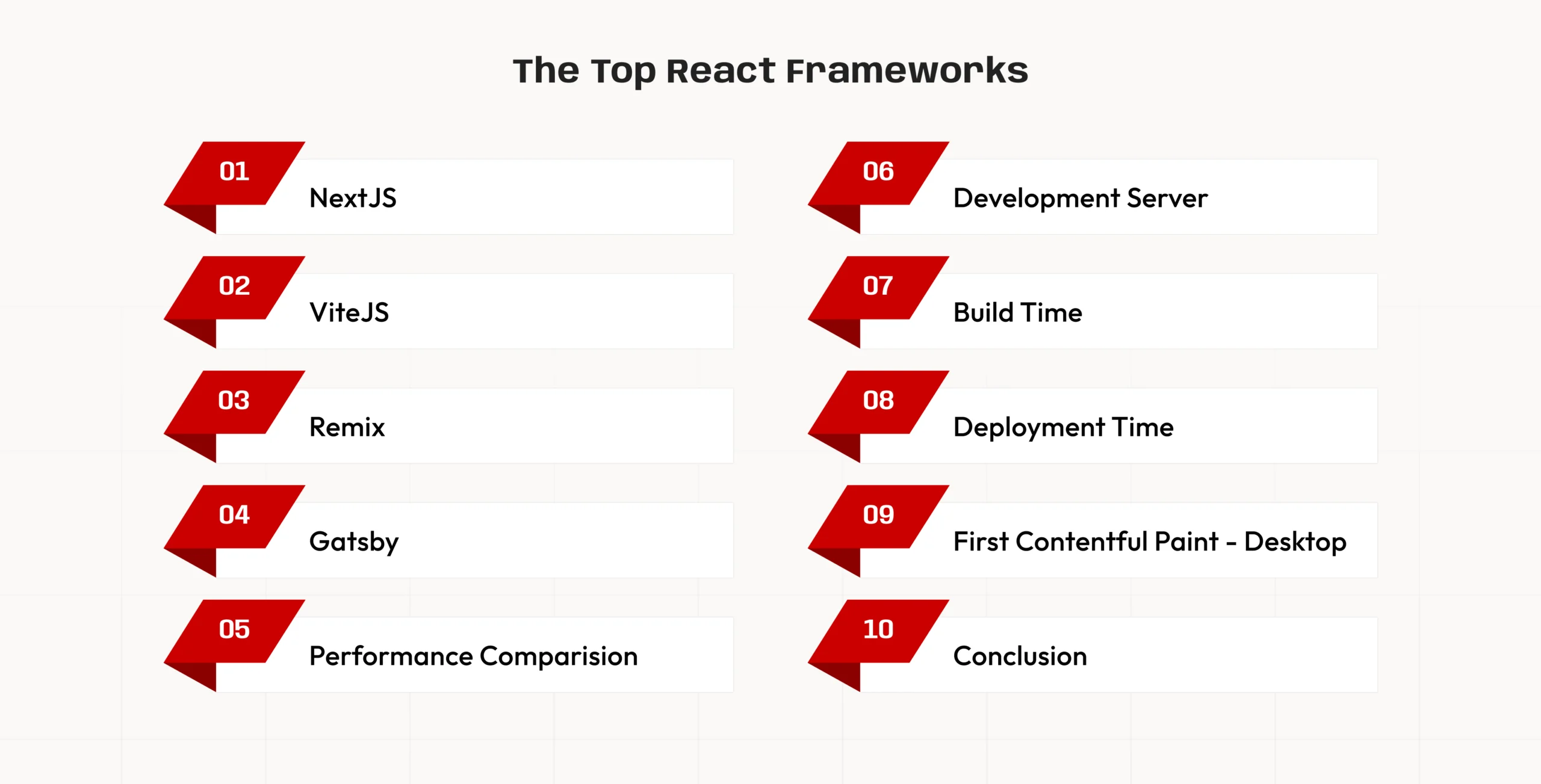Engagement Module
Next Gen AI Solution
Maintenance
Designing
Consultant
Industries
Comparing The Top React Frameworks

As with most of us seeking to learn React, we all started with the CRA(create-react-app) library, which is, of course, a nice place to start learning about React as a framework. However, in the present day, a developer shouldn’t build a project with it. Below are some of the reasons to avoid CRA these days:
- The build time is more extended when compared to competing frameworks.
- No way to completely control build options.
- No Server Side Rendering capacity
It’s obsolete because most major changes have not been made on CRA since the year 2021.
It is thus clear that there are many reasons for traditional CRA to be replaced with the present-day React framework which has so many more capabilities. There are various alternatives based on your requirements such as SSR, performance, etc.
Today, we are going to focus on some of the top alternatives to CRA. We are going to discuss
- Each alternative
- Their features and Best suits for which kind of application development
- Some performance metrics such as dev server time, build time, deployment time, and first contentful paint.
I hope this makes you happy. So, let’s get started.
Top React Frameworks

NextJS
Vercel’s Next.js framework is designed to support React in a full-stack fashion on the web.
Nextjs has been my favourite replacement for CRA. I have been using it for quite a while. With every version they release, NextJS continues to get better and better. They offer quite a few tools that should help any developer out there create projects with Nextjs.
Some of the Features of the Assessment Project:
- Server Side Rendering: One of the advantages that can be gained, thanks to the SSR, is the improvement of the load time since there are pre-rendered pages to load faster.
- API Routes: API routes allow to extend NextJS to full-stack development.
- Automatic Code Splitting: If the recommended structure of the projects is followed, better code splitting will be achieved. Helping to enhance performance.
- Easy Integration with Vercel: As it is the brainchild of Vercel, deploying NextJs with Vercel became a walk in the park.
Best suited for the development of a Serverless application that has little to no dependency on the server.
ViteJS
Prepare yourself for an advanced coding infrastructure that can keep pace, at last, with you. Vite concentrates more on performance to build quick-loading projects. Unlike traditional optimizers such as Webpack, Vite goes a step further by having a development server that allows hot module replacement of individual modules almost instantly, without having to wrap the whole application in one critical request. As a result, they can have a fast development server.
ViteJS Features:
- Even Faster Development Server: With native ES modules and modern browsers, it makes for a quicker development server.
- Plugin architecture: Supports a wide array of plugins. Need a different feature? Just add it to Vite’s capabilities.
- Build Optimizations: Optimal performance is achieved through tree shaking, code splitting, and other enhancements at the build stage.
- Server-Side Rendering and Static Site Generation: Vite allows Server Side Rendering and Static Site Generation for optimized performance as well.
Vite is ideal for creating portfolio or blog-based websites as they perform well.
Remix
There are several pages of user interface code which contain various web users’ interactions. When thinking about that, it is hard not to consider the web as an sqlalchemy full-stack web framework. When it comes to web design and development, there are numerous client and server MVC web frameworks on client-side and server-side computing paradigms we could follow. But if you have ever worked with server-side MVC web frameworks such as Rails or Laravel, the remix is the view and the controller.
Remix Features:
- Data Loading: It uses loaders to fetch data on the server before rendering the page.
- Simple Routing: File-based routing system is provided. It supports routing based on the folders you are going to create. This is also available in NextJS.
- Server Side Rendering: It also supports the SSR for providing better performance.
- Forms and Actions: Remix supports form-building and actions out of the box.
This helps to easily control the form submission and actions. It is most appropriate to construct a project that is looking at routing, SSR, and most importantly Performance.
Gatsby
Gatsby is an open-source front-end framework based on React that has performance, scaling, and security features built into it. Gatsby is the latest of all the frameworks created using React in the making of optimized and secured websites. It is mainly used for the development of static websites but it can also provide dynamic content through APIs and integrations.
Characteristics:
- Server Side Generation(SSG): It also accommodates Gatsby and generates static HTML files containing pre-rendered elements of the content.
- Progressive Web App: Provides full PWA features in Gatsby, which enables the provision of fast experiences ready for the web, capable of handling offline functions like mobile apps.
- JAMstack: JavaScript, APIs and Markup lets you create webpages by keeping all the pages on a CDN and making calls to backend endpoints when necessary.
- Content Management System: In Gatsby, it is a backend system in which content is created and that content is pulled to be used in building static sites using Gatsby.
Best suites for making a blog using a Content Management System which is accessed via Gatsby.
Performance Comparison
We have examined all the frameworks with their characteristics and examined the various types of content for which the framework is best suited. Now let us turn to some of the performance metrics: the time to start the development server, build time, deployment time, first contentful paint, etc.
For each of the frameworks, I created this project using an animation composed of images and JSX elements along with CSS. At this point, the content remains unchanged which in turn helps to assess the quality of the performance.
Development Server
No Data Found
From the graph, it can be seen that the ViteJS took the fastest time to get the server running while Gatsby took the longest. This is in line with the argument that ViteJS is one of the fastest frameworks available.
Build Time
No Data Found
The ViteJs is the most capable of finishing the building process in less amount of time. When it comes to building, however, Gatsby has shown the slowest speed. NextJS is on the verge of being the slowest as well.
Deployment Time
No Data Found
The entire structure has been set up on the vercel.
Out of the three frameworks experimented with, Vite managed to pull a world record of 12 seconds before the other two fast-falling behind NextJS and Gatsby. Remix on the other hand has been able to maintain position two across all the metrics.
First Contentful Paint - Desktop
When assessing the quintuple scores of the frameworks, it can be noted that all of them earn a perfect 100 score on the Desktop. However, the first contentful paint is slightly different from them.
No Data Found
In this scenario, NextJs and Gatsby were the most rapid among all the frameworks used whereas ViteJs and Remix were the most sluggish. The difference is as minimal as 0.1s between those.
You may view each of the PageSpeed Insight more closely here:
- Vercel
- ViteJS
- RemixJS
- Gatsby
Conclusion
To sum up, although Create React App (CRA) was a good option for most developers, it is evident that there are no other better options that are more advanced and resourceful. Each of the frameworks we covered – NextJS, ViteJS, Remix, and Gatsby – has its own set of use-specific advantages.
- NextJS is a good fit for those developers who desire to create applications capable of server rendering, together with smooth Vercel deployment.
- ViteJS performs, especially when it comes to development speed and is suitable for works that focus on very quick production.
- Remix is geared towards creating full-stack applications and offers a comprehensive system that has very sophisticated routing and server performance and excellent user experience.
- Gatsby is still popular among the instruments of static site generation, particularly for content-focused projects, which make good use of its internal optimization tools and PWA features.
In the end, it will be the goals of the project that will dictate the particular framework being selected: performance improvements, server-side rendering, quick deployment or a full-stack – all of these have different importance for various projects. You could greatly improve your development process and your project as a whole if you moved to one of these modern options away from CRA.
The appropriate framework selection is reliant on the requirements of the project. Solutions such as Braincuber help teams in assessing performance, dependency controls, and project status promulgations across these, so they select the framework most suitable for their goals and use cases.




